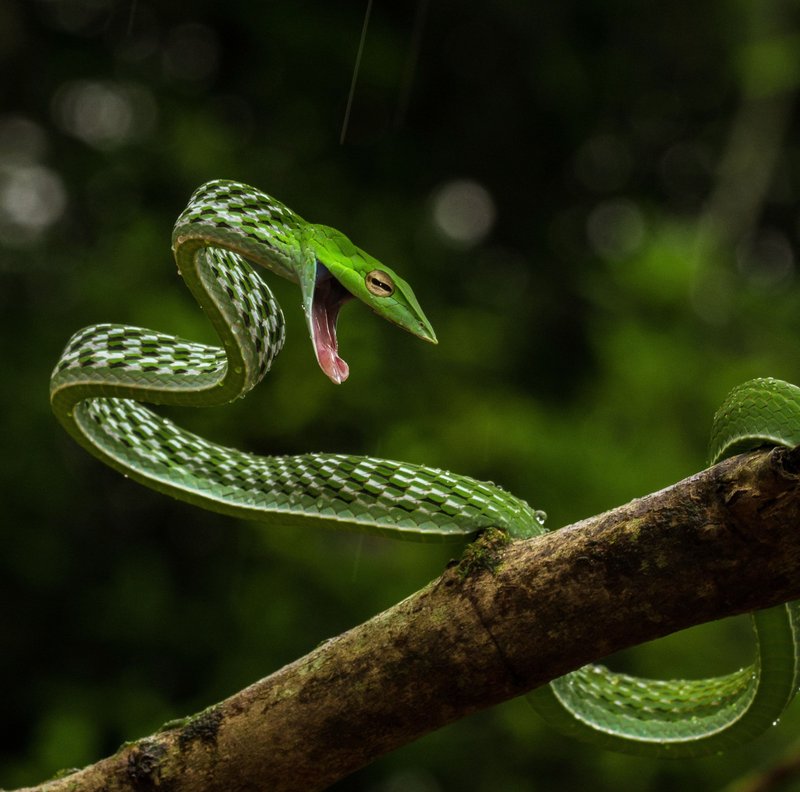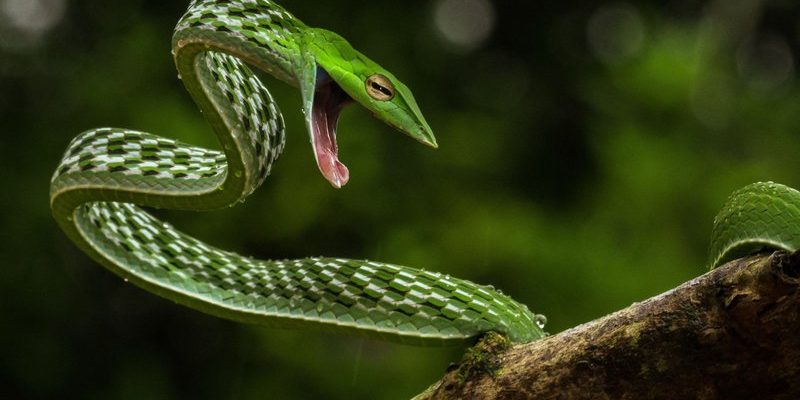
The Vine Snake, a remarkable serpent often found in tropical regions, is more than just a striking green color. With its long, slender body and uniquely camouflaged appearance, it merges seamlessly among foliage, making it a fascinating creature to study. Imagine walking through a lush, green jungle and glancing up to see a snake that looks just like a vine. This is nature’s ingenuity at work!
These snakes are part of the Colubridae family, which includes a vast array of non-venomous snakes. But don’t let that classification fool you; they’re far from ordinary. They exhibit extraordinary behaviors and adaptations that allow them to thrive in some of the most biodiverse environments on the planet. So, let’s delve into what makes the Vine Snake so special!
Physical Characteristics
The Vine Snake has a very distinct appearance. Its body is incredibly slender and elongated, typically measuring around three to six feet long. The head is narrow, which contributes to its ability to blend in with its surroundings. You might find it surprising to learn that despite their size, they are highly skilled at maneuvering through trees. The color of this snake is predominantly green, providing an excellent camouflage against the leaves and vines of their habitat.
Another key feature is their large, round eyes, which give them excellent vision. This allows them to spot prey from afar and evade predators. The eyes, often a bright yellow or orange, stand out against their green body, creating a striking contrast. Their scales are smooth, which not only helps them glide through foliage but also reflects the light in a way that enhances their natural camouflage.
Interestingly, the Vine Snake’s slender body is an adaptation for its lifestyle. They are arboreal, meaning they spend most of their time in trees. This body shape allows them to navigate with grace and agility, twisting and turning as they move through branches. It’s like watching a dancer perform, each movement purposeful and fluid.
Habitat and Distribution
You can find Vine Snakes primarily in Central and South America, particularly in countries like Colombia, Ecuador, and Brazil. These snakes prefer humid, tropical rainforests where they can easily camouflage themselves among branches and leaves. They typically dwell in the high canopies of trees, but you might spot them at lower levels during their hunting activities.
The rainforest ecosystem is rich with biodiversity, providing the Vine Snake with plenty of places to hide and hunt. These environments are teeming with prey, such as lizards and small mammals, which are essential to their diet. The lush foliage not only provides food but also protection from larger predators that might view them as a potential meal.
It’s important to note that environmental changes, such as deforestation and climate change, threaten the habitats of Vine Snakes. As rainforests are cut down for agriculture and urban development, these snakes lose their homes. Conservation efforts for tropical ecosystems are, therefore, crucial for the survival of not just the Vine Snake but countless species that share its habitat.
Diet and Hunting Techniques
The Vine Snake thrives on a diet primarily consisting of small lizards and occasionally frogs or other small animals. They are known for their unique hunting technique, which is quite different from many of their snake counterparts. Instead of relying on speed and surprise, they often wait patiently, camouflaged among the leaves, until their prey draws near.
Once a potential meal is within striking distance, the Vine Snake uses its quick reflexes to capture it with a swift lunge. This method capitalizes on their excellent vision and allows them to make the most of their slender bodies. You might think of it like a cat lying in wait for a mouse; patience is key.
Interestingly, Vine Snakes are non-venomous, which means they rely on constriction to subdue their prey. After catching a lizard, they will wrap around it tightly, ensuring it has no chance to escape. This technique showcases not just their hunting prowess but also how adapted they are to their specific feeding habits.
Behavior and Social Structure
The behavior of the Vine Snake is as captivating as its appearance. These snakes are generally solitary creatures. They prefer to go about their activities alone, whether hunting or basking in the sun, but there are times when you might observe them interacting, especially during the mating season. Mating usually occurs in the rainy season, which coincides with the abundance of prey, giving hatchlings a better chance of survival.
While they are typically non-aggressive, Vine Snakes will defend themselves if threatened. When disturbed, they may flatten their bodies and display their bright colors as a warning sign to potential predators. This display can often deter larger animals and is a fascinating aspect of their behavior.
Moreover, these snakes are quite adept at navigating their environment due to their long bodies and flexible spines. When traversing the trees, they utilize a unique form of locomotion that allows them to move with stealth and precision, making them excellent ambush predators.
Reproduction and Lifespan
Reproduction in Vine Snakes is relatively straightforward. Females will lay eggs, typically between six to twelve at a time, depending on their size and health. The eggs are often hidden among foliage to protect them from predators. After several weeks, depending on the temperature and humidity, the eggs will hatch, releasing baby snakes that are miniature versions of their parents.
Once hatched, these young snakes are independent and must fend for themselves right away. They are vulnerable to numerous threats, including birds and larger predators. However, their excellent camouflage helps them stay hidden, allowing them a fighting chance in their lush surroundings.
In the wild, Vine Snakes can live for several years—usually around four to seven years, although some may live longer with optimal conditions. The lifespan varies based on factors such as habitat quality, food availability, and threats from predators.
Conservation Status
The Vine Snake is currently not listed as threatened, thanks mainly to its wide distribution and adaptability. However, the ongoing destruction of rainforests poses a significant risk to their habitats. As conservation efforts continue globally, protecting the rainforest ecosystems becomes increasingly critical not just for the Vine Snake but for countless other species that call these lush environments home.
Awareness and education about the plight of tropical wildlife can help foster appreciation and support for these natural habitats. By promoting sustainable practices and supporting conservation initiatives, we can all play a role in protecting these incredible creatures.
Moreover, as urban areas expand, wildlife corridors and protected zones become crucial in allowing species like the Vine Snake to thrive and survive amid human activity. It’s a challenging balance, but with concerted efforts, there’s hope for these stunning snakes and their ecosystems.
| Fact | Description |
| Size | 3 to 6 feet long |
| Habitat | Tropical rainforests |
| Diet | Small lizards and occasionally frogs |
| Lifespan | 4 to 7 years, sometimes longer |
| Conservation Status | Not currently threatened |
FAQ
What do Vine Snakes eat?
Vine Snakes primarily feed on small lizards, but they may also eat frogs and other small creatures in their environment. Their hunting strategy involves waiting patiently for prey to come close, allowing them to strike quickly. This diet is suited to their habitat, where they can easily ambush their meals among the foliage.
Are Vine Snakes venomous?
No, Vine Snakes are not venomous. They rely on their agility and camouflage to hunt and evade predators. Instead of using venom, they capture prey by constriction, wrapping around it tightly to subdue it. This non-venomous nature makes them less dangerous to humans, although caution is always advised when handling snakes.
How do Vine Snakes camouflage themselves?
Vine Snakes have predominantly green bodies that mimic the appearance of vines and leaves in their natural habitat. This coloring, combined with their slender shape, allows them to blend in seamlessly with the foliage. When resting or waiting for prey, they can become nearly invisible, making it easier for them to avoid predators.
Where can I find Vine Snakes in the wild?
Vine Snakes are native to Central and South America and are typically found in tropical rainforests. They thrive in regions with dense foliage where they can easily camouflage themselves. Locations like Colombia, Ecuador, and Brazil are some of their preferred habitats.
How long do Vine Snakes live?
In the wild, Vine Snakes can live for about four to seven years, though some may live longer depending on environmental conditions and threats. Factors like available food and habitat quality can significantly affect their lifespan.
What makes Vine Snakes unique among other snakes?
Vine Snakes are unique due to their long, slender bodies and exceptional camouflage that mimics vines. Their non-venomous nature and their hunting methods set them apart from many other snakes. Additionally, their arboreal lifestyle and ability to navigate through trees with grace showcase their adaptations to their environment.
Are Vine Snakes social animals?
No, Vine Snakes are primarily solitary creatures. They tend to go about their activities alone and interact mainly during the mating season. Unlike some snakes that may form groups, Vine Snakes prefer to maintain their independence.
How do Vine Snakes reproduce?
Vine Snakes reproduce by laying eggs, typically hidden among foliage to protect them from predators. After several weeks of incubation, the eggs hatch, releasing young snakes that are independent from birth. This reproductive strategy helps ensure the survival of the species in their challenging environments.
What are the biggest threats to Vine Snakes?
The biggest threats to Vine Snakes include habitat loss due to deforestation and climate change. As rainforests are being cleared for agriculture and development, these snakes lose their natural habitats, putting their populations at risk. Conservation efforts are crucial to address these challenges and protect their ecosystems.
Can Vine Snakes be kept as pets?
While it is possible to keep Vine Snakes as pets, they require specialized care and a suitable environment that mimics their natural habitat. A spacious enclosure with plenty of vertical space for climbing and proper humidity levels is necessary. Additionally, potential owners should research their behavior and needs thoroughly before deciding to keep one as a pet.
What is the role of Vine Snakes in their ecosystem?
Vine Snakes play a vital role in their ecosystems as both predators and prey. They help control populations of small lizards and other insects, which can balance the ecosystem. Additionally, they serve as a food source for larger predators, contributing to the overall food web in their tropical environments.

